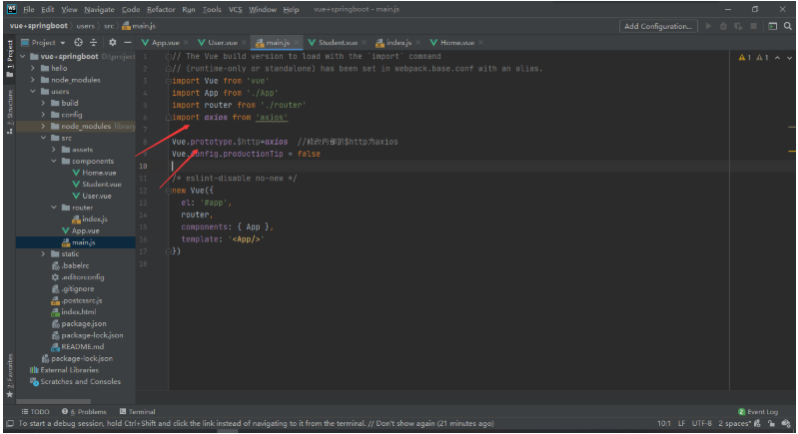Axios的基本使用
axios
axios引言
axios 是一个
异步请求技术
异步请求
基于XMLHttpRequest对象发起的请求都是异步请求
异步请求特点
请求之后页面不动,响应回来更新的是页面的局部,多个请求之间互不影响,并行执行
为什么不用ajax了?
ajax确实用来发送异步请求,但是有点过气了
因为现在流行的系统架构是前后端分离架构系统 ------>异步请求技术----------> vue 全家桶系列 前端技术端 vue淘汰了jquery
axios基本使用
在vue cli中使用axios的方法
1 安装
npm install axios --save-dev
2 配置
在main.js中import axios from 'axios'
并且添加Vue.prototype.$http=axios //修改内部的$http为axios
3 使用axios
配置环境
在vue cli中安装axios
# 1 安装
npm install axios --save-dev
# 2 配置
在main.js中import axios from 'axios'
并且添加Vue.prototype.$http=axios //修改内部的$http为axios
# 3 使用axios
在需要发送异步请求的位置:this.$http.get("url").then((res)=>{}) this.$http.post("url").then((res)=>{})

在html中使用axios
<script src="https://unpkg.com/axios/dist/axios.min.js"></script>
axios的第一个应用
Example
GET方式请求测试
<!DOCTYPE html>
<html lang="en">
<head>
<meta charset="UTF-8">
<title>Title</title>
<!--引入axios相关依赖-->
<script> //get方式请求
axios.get('http://localhost:8080/axios/findAll?username=zhangsan&password=123')//代表发送请求的url,传参直接放在url后面
.then(function (response) {
console.log(response.data);
})//代表响应回来出发的回调函数
.catch(function (err) {
console.log(err);
});
</script>
</head>
<body>
</body>
</html>
post方式的请求
<script>
//post方式请求
axios.post('http://localhost:8080/axios/save',{name: "longda",age: 23})//代表发送请求的url,传参对象放在后面
.then(function (response) {
console.log(response.data);
})//代表响应回来出发的回调函数
.catch(function (err) {
console.log(err);
});
</script>
注意
##
1 axios在发送post方式的请求时传递的参数如果为对象类型,axios会自动将对象**转化为json格式的字符串**使用 application/json的请求头向后端服务接口传递参数
##
2 axios的post请求传递参数的两种方式:
# 第一种
使用字符串进行参数传递:"name=zhangsan&age=23"
# 第二种
后端接口直接使用@RequestBody注解形式接收参数
Axios的并发请求
并发请求:在同一时间发送多个不同的请求到后端服务,最后统一处理不同服务的响应结果
<script>
//并发请求: 在同一时间发送多个
function findAll() {
return axios.get("http://localhost:8080/axios/findAll?username=xxx&passwod=123")
}
function save() {
return axios.post("http://localhost:8080/axios/save",{name: "xxx",age: 23})
}
//并行发送
axios.all([findAll(),save()]).then(
axios.spread(function (result1,result2) {
console.log(result1.data);
console.log(result2.data);
})//用来统一处理多个并发请求的执行结果
);//处理并发请求
</script>
总结
##
1 针对与并发请求需要用到axios.all()函数来完成并发请求的处理
2 正对于并发请求的结果汇总需要使用axios.spread()函数来统一汇总请求结果
Axios的Restful风格的API
# Axios的API总结
axios.request(config)
axios.get(url[, config])
axios.delete(url[, config])
axios.head(url[, config])
axios.options(url[, config])
axios.post(url[, data[, config]])
axios.put(url[, data[, config]])
axios.patch(url[, data[, config]])
# 注释:
当使用以上别名方法时,url,method和data等属性不用在config重复声明。
Axios的高级使用 配置对象
1 配置对象
{
// `url` 是请求的接口地址
url: '/user',
// `method` 是请求的方法
method: 'get', // 默认值
// 如果url不是绝对路径,那么会将baseURL和url拼接作为请求的接口地址
// 用来区分不同环境,建议使用
baseURL: 'https://some-domain.com/api/',
// 用于请求之前对请求数据进行操作
// 只用当请求方法为‘PUT’,‘POST’和‘PATCH’时可用
// 最后一个函数需return出相应数据
// 可以修改headers
transformRequest: [function (data, headers) {
// 可以对data做任何操作
return data;
}],
// 用于对相应数据进行处理
// 它会通过then或者catch
transformResponse: [function (data) {
// 可以对data做任何操作
return data;
}],
// `headers` are custom headers to be sent
headers: {'X-Requested-With': 'XMLHttpRequest'},
// URL参数
// 必须是一个纯对象或者 URL参数对象
params: {
ID: 12345
},
// 是一个可选的函数负责序列化`params`
// (e.g. https://www.npmjs.com/package/qs, http://api.jquery.com/jquery.param/)
paramsSerializer: function(params) {
return Qs.stringify(params, {arrayFormat: 'brackets'})
},
// 请求体数据
// 只有当请求方法为'PUT', 'POST',和'PATCH'时可用
// 当没有设置`transformRequest`时,必须是以下几种格式
// - string, plain object, ArrayBuffer, ArrayBufferView, URLSearchParams
// - Browser only: FormData, File, Blob
// - Node only: Stream, Buffer
data: {
firstName: 'Fred'
},
// 请求超时时间(毫秒)
timeout: 1000,
// 是否携带cookie信息
withCredentials: false, // default
// 统一处理request让测试更加容易
// 返回一个promise并提供一个可用的response
// 其实我并不知道这个是干嘛的!!!!
// (see lib/adapters/README.md).
adapter: function (config) {
/* ... */
},
// `auth` indicates that HTTP Basic auth should be used, and supplies credentials.
// This will set an `Authorization` header, overwriting any existing
// `Authorization` custom headers you have set using `headers`.
auth: {
username: 'janedoe',
password: 's00pers3cret'
},
// 响应格式
// 可选项 'arraybuffer', 'blob', 'document', 'json', 'text', 'stream'
responseType: 'json', // 默认值是json
// `xsrfCookieName` is the name of the cookie to use as a value for xsrf token
xsrfCookieName: 'XSRF-TOKEN', // default
// `xsrfHeaderName` is the name of the http header that carries the xsrf token value
xsrfHeaderName: 'X-XSRF-TOKEN', // default
// 处理上传进度事件
onUploadProgress: function (progressEvent) {
// Do whatever you want with the native progress event
},
// 处理下载进度事件
onDownloadProgress: function (progressEvent) {
// Do whatever you want with the native progress event
},
// 设置http响应内容的最大长度
maxContentLength: 2000,
// 定义可获得的http响应状态码
// return true、设置为null或者undefined,promise将resolved,否则将rejected
validateStatus: function (status) {
return status >= 200 && status < 300; // default
},
// `maxRedirects` defines the maximum number of redirects to follow in node.js.
// If set to 0, no redirects will be followed.
// 最大重定向次数?没用过不清楚
maxRedirects: 5, // default
// `httpAgent` and `httpsAgent` define a custom agent to be used when performing http
// and https requests, respectively, in node.js. This allows options to be added like
// `keepAlive` that are not enabled by default.
httpAgent: new http.Agent({ keepAlive: true }),
httpsAgent: new https.Agent({ keepAlive: true }),
// 'proxy' defines the hostname and port of the proxy server
// Use `false` to disable proxies, ignoring environment variables.
// `auth` indicates that HTTP Basic auth should be used to connect to the proxy, and
// supplies credentials.
// This will set an `Proxy-Authorization` header, overwriting any existing
// `Proxy-Authorization` custom headers you have set using `headers`.
// 代理
proxy: {
host: '127.0.0.1',
port: 9000,
auth: {
username: 'mikeymike',
password: 'rapunz3l'
}
},
// `cancelToken` specifies a cancel token that can be used to cancel the request
// (see Cancellation section below for details)
// 用于取消请求?又是一个不知道怎么用的配置项
cancelToken: new CancelToken(function (cancel) {
})
}
使用配置对象形式发送请求
axios.create({
method:'GET',
url: '',
baseURL: ''
})
var instance = axios.create({
method: "GET",
//公共的url放在一起
baseURL:"http://localhost:8080",
data:{ //作为请求体发送的数据,只适用于这些请求方法 'PUT','POST',和'PATCH'
username:"xiaohei"
}
});
//访问不同的url(拼接在baseURL后面)
instance.get("/axios/findAll?username='zhangsan'")



 浙公网安备 33010602011771号
浙公网安备 33010602011771号